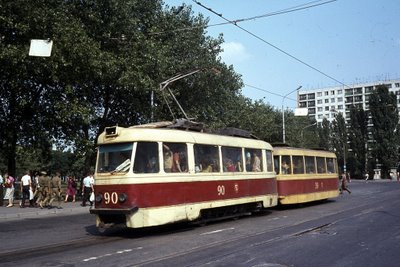 The next day we drove southwards from Iasi to Galati. The main problem with a right hand drive car was overtaking the many horse-drawn carts that were used for general transport in the rural areas. Getting petrol was a problem because in the towns there was usually a queue about a mile long at each of the few petrol stations. The cars were parked at the side of the road with their engines switched off and when the queue moved they were pushed. In the countryside there were few queues. We saw petrol stations with high octane petrol between Iasi and Galati and arrived with a fairly low tank. Sure enough there was a queue of cars along the road and out of sight round a corner. We drove along and then I saw a gap near the front and drove into it expecting to be sworn at in Romanian. A crowd surrounded the car calling out 'pumpe speciale' and escorted us to the special pump (for party leaders perhaps) and then they all admired our luxury Ford Cortina and gave us a friendly wave as we left.
The next day we drove southwards from Iasi to Galati. The main problem with a right hand drive car was overtaking the many horse-drawn carts that were used for general transport in the rural areas. Getting petrol was a problem because in the towns there was usually a queue about a mile long at each of the few petrol stations. The cars were parked at the side of the road with their engines switched off and when the queue moved they were pushed. In the countryside there were few queues. We saw petrol stations with high octane petrol between Iasi and Galati and arrived with a fairly low tank. Sure enough there was a queue of cars along the road and out of sight round a corner. We drove along and then I saw a gap near the front and drove into it expecting to be sworn at in Romanian. A crowd surrounded the car calling out 'pumpe speciale' and escorted us to the special pump (for party leaders perhaps) and then they all admired our luxury Ford Cortina and gave us a friendly wave as we left.1. This well is at a world famous painted church.
2. Typical horse drawn carts.
3. Making friends with a local on a ferry.
4. We will always remember this hotel. On arrival it looked better than the previous ones and it even had a multi-lingual menu in the dining room. We each chose someting different but the elderly waiter mumbled someting and disappeared, returing with the young man from the reception desk who said 'We are not rich in food!'. All they had were chips, some cold ham and some cucumber. Towards the end of this banquet a local asked to change money and I was so fed up that I followed him to the gents and got about 5 times the official rate of exchange which made things more affordable. That was the first time I changed money on the black market.


















